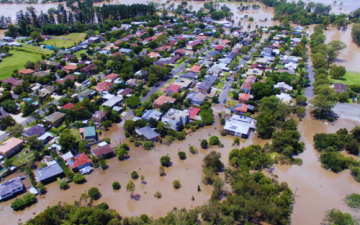Descartes Underwriting’s Business Development Director of UK & Ireland, Paul Jones, shares his insights on natural peril evolution and how market circumstances are significantly impacting the insurance industry. Read on to discover Paul’s observations on how parametric products are gaining profound traction in domestic and international markets, while capacity constraints continue to challenge traditional carriers.
What is your perspective on the current market conditions across the UK and Ireland?
The property market is experiencing a hardening period; in the last 3-4 years, we have seen rate changes consistently quarter on quarter. This will accelerate in 2023. We will see a difference in the reinsurance treaty placements from January 1 and how risk carriers buy their reinsurance, whether they restructure, buy more or buy less limit.
With the pound plummeting by more than 3 percent and inflation rising, how is this impacting the insurance industry across the markets? Or how will this transition start to look?
The strength of the pound against the dollar and the euro is a concern. As a consumer, the appetite to buy more insurance will reduce, and people will retain more risk. They will self-insure and set up captive vehicles.
The latest reports from large reinsurance brokers suggest that capital provision will reduce by 11 to 12 percent. Even before Hurricane Ian, it was already a terrible CAT year across the market, so this will only accelerate the reinsurance market’s challenges. Regarding underinsurance, buyers will continue to be challenged regarding their purchase priority due to inflation and the worsening climate.
Insurance buyers will have to prioritize what they purchase in the insurance market and how they buy, and brokers will have a critical role in this process. When you look at tangible assets and risks, there has been a shift over the last ten years, in terms of assessing what the priority is and what buyers are focusing on. Would you consider not buying Nat Cat cover for your critical infrastructure? Highly unlikely.

What are the current capacity constraints in the UK & Ireland?
The UK domestic market is still very robust in terms of capacity provision. The real issue is for UK domestic buyers that have exposure overseas. When you look at risks for global programs, there are heavy sub-limits for specific risk areas, such as Nat Cat. If you’re operating a billion-dollar location where you can only get $200 million worth of earthquake cover, that’s a problem. We will start seeing buyers look at their assets overseas differently, not just their own assets but also third-party suppliers and unknown locations.
For supply chain risk, accessing alternative supply lines might be risk buyers’ only option, as their primary site is no longer available. That may be due to a CAT reason or an FLE peril that has impacted a particular location. Yet the indemnity market is very stringent on what covers they will give to which locations that aren’t risk managed by the same client. In a global economy with global supply chains, there will be a very high priority for insurance managers and risk management practices to look at each tier of their supply chain.
Could you explain the parametric value proposition through water utilities in the market region and how they are facing weather & climate exposures not addressed by traditional insurance?
There’s a lot of legislation in the UK regarding water companies and how they’re regulated; you must use a particular water company if you live in a specific region. There’s no consumer choice.
With each 0.1% global temperature increase, we’re 8 percent more exposed to flooding or heavy precipitation events in the UK. Water processing costs increase when there is a severe precipitation event because water companies have to draw more electricity to process greater volumes of water while still meeting customer demand. Those processing costs increased with rising electricity prices and increased frequency of flood events. Yet, due to the AMP process instilled by the regulator, the water companies cannot pass on that cost to the consumer.
Therefore, flood is one peril where a parametric product can offer solutions for a highly critical exposure in the UK. We’ve seen deductibles as low as 200k for flood and as high as £25m. A parametric flood cover and our partnerships with data providers can offer solutions for critical locations and for companies to protect their balance sheets from the funding of these deductibles.

What are the main climate risks for the agricultural sector right now?
In terms of agriculture, it varies depending on the crop. Generally, farmers have many fixed costs that don’t change regardless of if they have a good harvest, or if the yield is reduced significantly. The sum of fixed costs will stay the same and they still have to pay to reseed for the next year. The contract demands are fixed to meet the yield prescribed for how much land will be seeded.
Whether faced with drought exposure, flood, or frost, these risks can all aggregate into a significant problem for the farming community with regard to fixed costs and contractual demands.
Parametric solutions are very flexible and structured to be fully client-customized. We can even cover critical growing periods against multiple perils. For example, in the event of significant rainfall during a crucial harvesting period, farmers may be unable to get heavy machinery onto the field. Based on the client’s needs, our insurance products can be tailored to have, a 2-week policy can cover this risk.
What does the future look like for natural catastrophes across the UK, Irish and London markets?
Quite bleak; we can’t call catastrophic events anomalies anymore. From an insurance perspective, it’s not as grim, but it will become more challenging. Traditional insurers cannot sustain their current position, and their models cannot keep pace, at least not in the same way parametric insurance and advancing technologies can with the changing environment.
From a Nat Cat perspective, it will force brokers and clients to look for alternative forms of risk transfer. Whether that’s looking at parametric insurance as a form of Nat Cat risk transfer or clients starting to set up their own captive vehicles or more protected cells.
When you look at Hurricane Ian, industry losses estimates are between 50-75 billion; this is a wide range. How it will play out is difficult to know. We will see reinsurers and ILS vehicles, who have never had losses before, start to see loss creep into their layers. Both because it’s a significant industry event and due to inflation. Pricing will increase, and appetite will reduce as less capital comes into the market, ultimately filtering down to the end customer.
Where do you see the parametric market going in the future?
With parametric insurance, the modeling is much more granular, incorporating stochastic climate change events, client location and historical losses to provide more certainty regarding actual loss when the event occurs. And that loss can be both physical damage and/or non-damage business interruptions that carry financial implications.
As a claim is paid within a few days, carriers are not holding future losses on their balance sheet when they’re covered by parametric products. This benefits the customer. Also, in the current hard market context, the fact that capital is still going into parametric lines of business means that there is still confidence in our ability to transfer risk more precisely than in the traditional indemnity market. The future for this type of parametric risk transfer looks incredibly bright.



